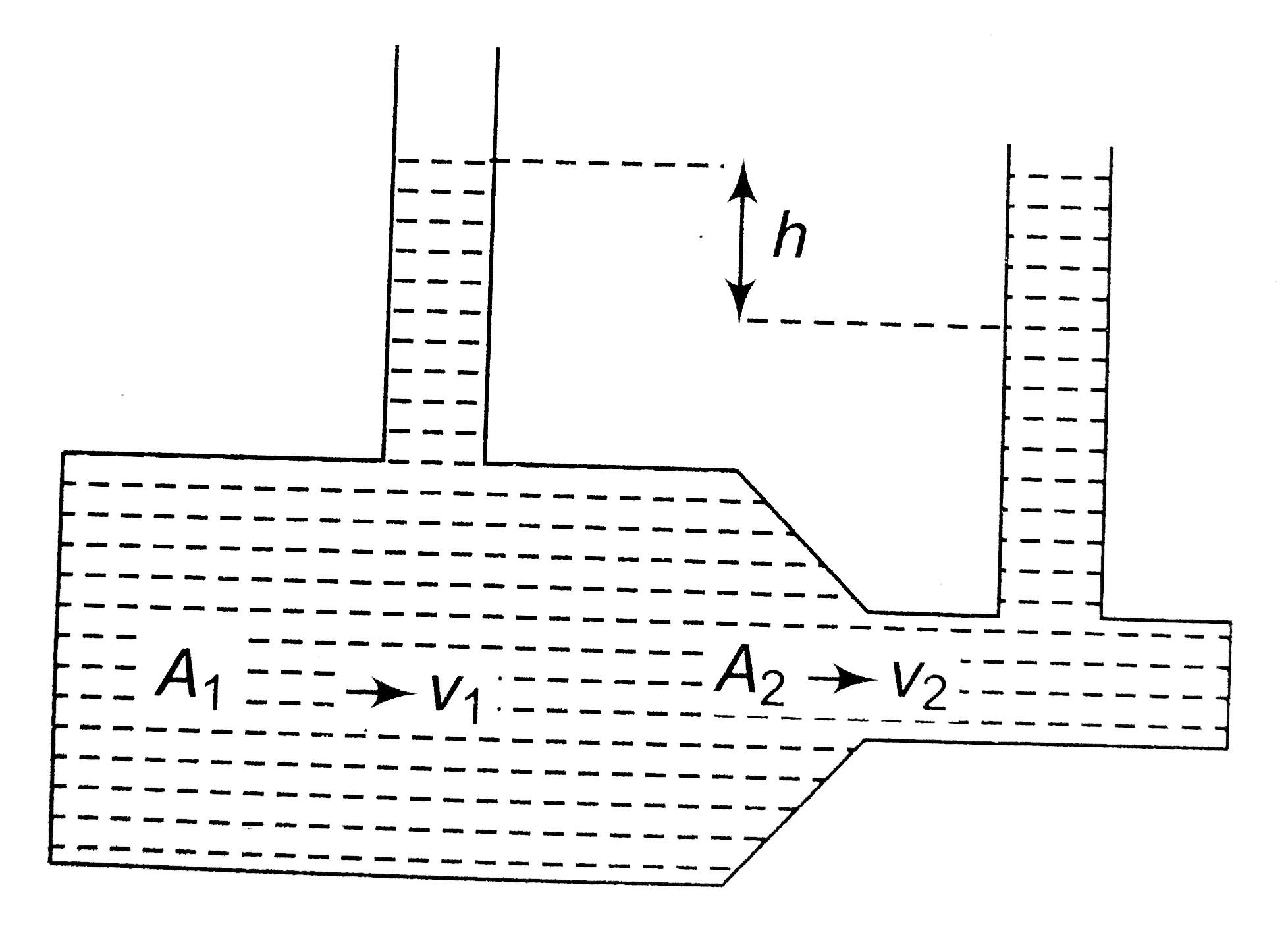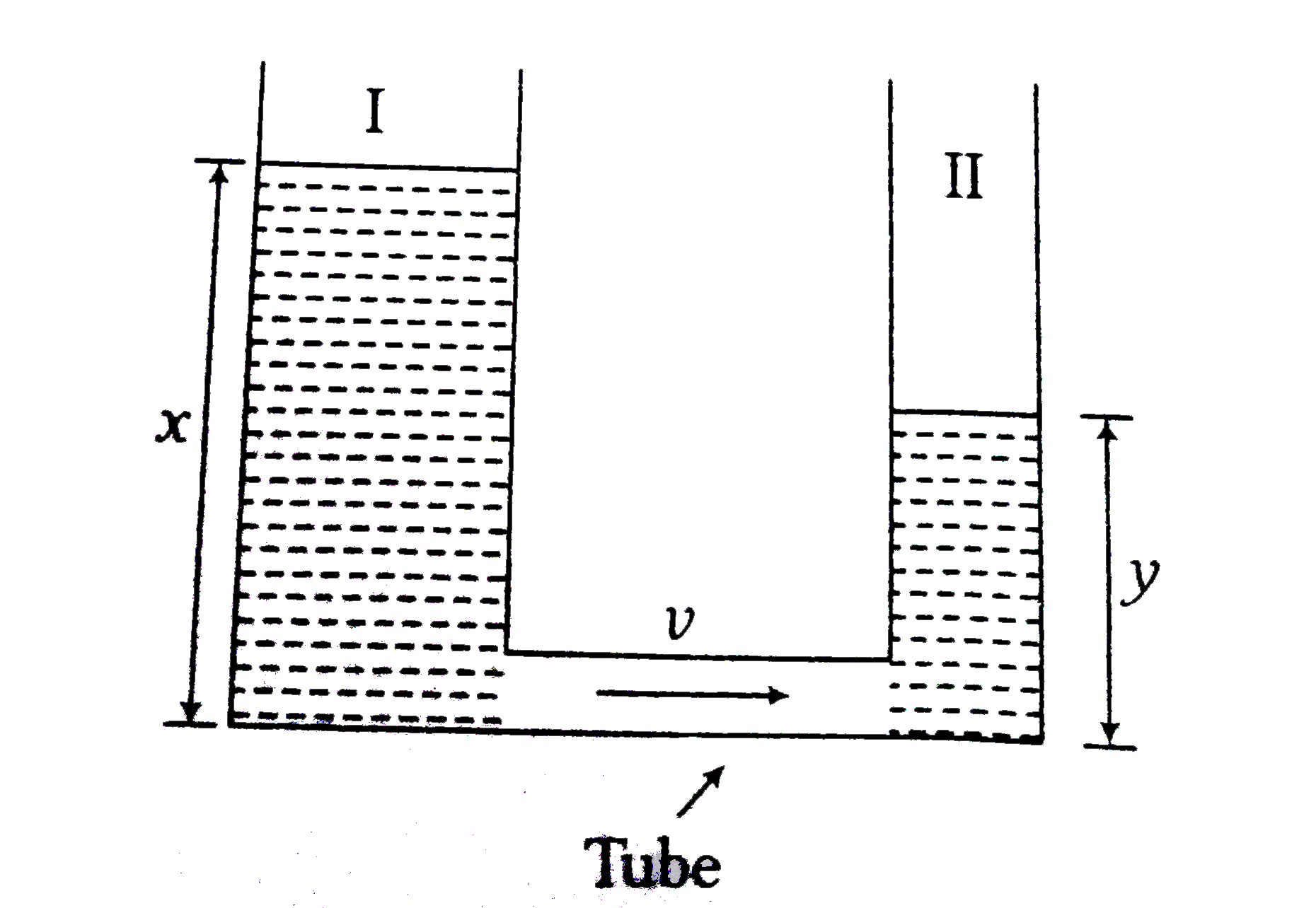A liquid of density 750kgm−3 flows smoothly through a horizontal pipe that tapers in cross-sectional area from A1=1.2×10−2m2 to A2=A12. The pressure difference between the wide and narrow sections of the pipe is 4500 Pa. The rate of flow of liquid is ________ ×10−3m3s−1.
The correct Answer is:24
To solve the problem step by step, we will use the principles of fluid dynamics, specifically the continuity equation and Bernoulli's equation.
Step 1: Identify the given data
- Density of the liquid, ρ=750kg/m3
- Cross-sectional area at the wide section, A1=1.2×10−2m2
- Cross-sectional area at the narrow section, A2=A12=1.2×10−22=0.6×10−2m2
- Pressure difference, P1−P2=4500Pa
Step 2: Apply the continuity equation
According to the continuity equation, the volume flow rate must be constant throughout the pipe:
A1V1=A2V2
From this, we can express V2 in terms of V1:
V2=A1A2V1=1.2×10−20.6×10−2V1=2V1
Step 3: Apply Bernoulli's equation
Using Bernoulli's equation between the two sections of the pipe, we have:
P1+12ρV21=P2+12ρV22
Rearranging gives:
P1−P2=12ρV22−12ρV21
Substituting the pressure difference:
4500=12ρ(V22−V21)
Step 4: Substitute V2 in the equation
Substituting V2=2V1:
4500=12ρ((2V1)2−V21)
This simplifies to:
4500=12ρ(4V21−V21)=12ρ(3V21)
Step 5: Solve for V21
Now, substituting the value of ρ:
4500=12×750×3V21
Calculating the right-hand side:
4500=22502V21
4500=1125V21
Now, solving for V21:
V21=45001125=4
Thus,
V1=2m/s
Step 6: Calculate the volume flow rate
Using the volume flow rate formula:
Q=A1V1
Substituting the values:
Q=1.2×10−2×2=2.4×10−2m3/s
Step 7: Convert to the required format
To express the flow rate in m3/s in the form of xx×10−3:
Q=2.4×10−2=24×10−3m3/s
Final Answer
The rate of flow of liquid is 24×10−3m3/s.
---
- Density of the liquid, ρ=750kg/m3
- Cross-sectional area at the wide section, A1=1.2×10−2m2
- Cross-sectional area at the narrow section, A2=A12=1.2×10−22=0.6×10−2m2
- Pressure difference, P1−P2=4500Pa
According to the continuity equation, the volume flow rate must be constant throughout the pipe:
Using Bernoulli's equation between the two sections of the pipe, we have:
Substituting V2=2V1:
Now, substituting the value of ρ:
Using the volume flow rate formula:
To express the flow rate in m3/s in the form of xx×10−3:
The rate of flow of liquid is 24×10−3m3/s.
Topper's Solved these Questions
- BOOK - JEE MAINS PREVIOUS YEARCHAPTER - JEE MAINS 2022EXERCISE - PART : PHYSICS30videos
JEE MAINS 2022
- BOOK - JEE MAINS PREVIOUS YEARCHAPTER - JEE MAINS 2022EXERCISE - PHYSICS (SECTION -A)20videos
JEE MAINS 2022
- BOOK - JEE MAINS PREVIOUS YEARCHAPTER - JEE MAINS 2022EXERCISE - Physics-Section B10videos
JEE MAINS 2022
- BOOK - JEE MAINS PREVIOUS YEARCHAPTER - JEE MAINS 2021EXERCISE - Physics (Section B )10videos
JEE MAINS 2021
- BOOK - JEE MAINS PREVIOUS YEARCHAPTER - JEE MAINS 2023 JAN ACTUAL PAPEREXERCISE - Question360videos
JEE MAINS 2023 JAN ACTUAL PAPER
Similar Questions
Ethanol of density ρ=791kg/m3 flows smoothly through a horizontal pipe that tapers (as in Fig ) in cross-sectional area from A1=1.20×10−3m2 to A2=A1/2 . The pressure difference between the wide and narrow sectional of pipe is 4120 Pa. What is the volume flow rate Rv of the ethanol ?
View SolutionA liquid of density 900 kg/m flows through a horizontal pipe that has a cross-sectional area of 1.90×10−2m2 in region A and a cross-sectional area of 9.50×10−2m2 in region B. The pressure difference between the two regions is 720×103 Pa. What are (a) the volume flow rate and (b) the mass flow rate?
View Solution
Knowledge Check
- Question 1 - Select One or More
A liquid flows through a horizontal tube. The velocities of the liquid in the two sections, which have areas of cross section A1 and A2 are v1 and v2 respectively. The difference in the levels of the liquid in the two vertical tubes is h. Then
 Athe volume of the liquid flowing through the tube in unit time is A1v1Bv2−v1=√2ghCv22−v21=2ghDthe energy per unit mass of the liquid is the same in both sections of the tube
Athe volume of the liquid flowing through the tube in unit time is A1v1Bv2−v1=√2ghCv22−v21=2ghDthe energy per unit mass of the liquid is the same in both sections of the tube - Question 2 - Select One
From a horizontal tube with area of cross-section A1 and A2 as shosn in fiugre liquid is flowing in the level of the liauid in the two veritcal tunes is h.
 AThe volume of the liquid flowing through the tube in time is A1v1Bv2−v1=√2ghCv22−v11=2ghDThe energy per unit mass of the liquid is the same in both sections of the tube
AThe volume of the liquid flowing through the tube in time is A1v1Bv2−v1=√2ghCv22−v11=2ghDThe energy per unit mass of the liquid is the same in both sections of the tube - Question 3 - Select One
A liquid flows through a horizontal tube as shown in figure. The velocities of the liquid in the two sections, which have areas of cross-section A1 and A2 and v1 and v2 respectively. The difference in the levels of the liquid in the two vertical tubes is h, then
 Av22−v21=2ghBv22+v21=2ghCv22−v21=ghDv22+v21=gh
Av22−v21=2ghBv22+v21=2ghCv22−v21=ghDv22+v21=gh
Water is flowing with a speed of 2m/s in a horizontal pipe with cross-sectional area decreasing from 2×10−2m2 to 0.01m2 at pressure 4×104 pascal. What will be the pressure at smaller cross-section?
View SolutionWater flow through a horizontal pipe. The area of cross-second at one place A1=10cm2, velocity of water flow is 1ms−1 and pressure is 2000 Pa. At another place area A2=5cm2. Whate is the pressure at area A2 ?
View SolutionA current of 4.8 A is flowing in a copper wire of cross-sectional area 3×10−4m2. Find the current density in the wire.
View SolutionWater at a pressure of 4×104Nm−2 flows at 2ms−1 through a horizontal pope of 0.02m2. What is the pressure in the smaller cross-section of the pipe?
View SolutionIf cross- sectional area of limb I is A1 and that of limb II is A2 then velocity of the liquid in the tube will be, (cross- sectional area of tube is very small)
 View Solution
View Solution

